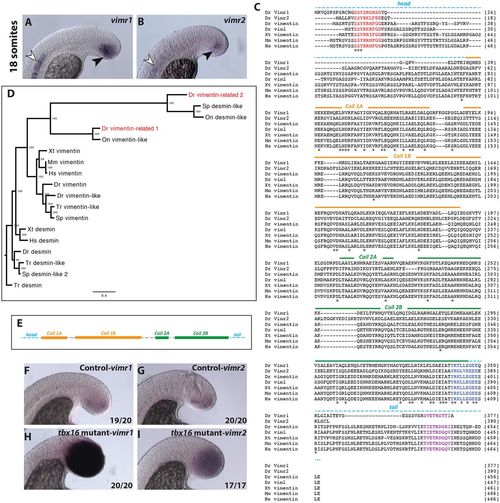Fig. 2
- ID
- ZDB-FIG-170516-39
- Publication
- Goto et al., 2017 - FGF and canonical Wnt signaling cooperate to induce paraxial mesoderm from tailbud neuromesodermal progenitors through regulation of a two-step EMT
- Other Figures
- All Figure Page
- Back to All Figure Page
|
Two vimentin-related genes, vimr1 and vimr2, are expressed specifically in cells undergoing EMT in the tailbud. Expression pattern of vimr1 (A) and vimr2 (B) in wild-type 18-somite stage embryos. Expression of both genes is limited to the notochord and tailbud cells during somitogenesis (white arrowheads indicate notochord expression, black arrowheads tailbud expression). (C) Protein alignment derived from vimentin gene sequences. Red indicates a highly conserved motif, which has been shown to have a role in vimentin assembly (Herrmann et al., 1992); blue indicates the helix termination motif and purple indicates the beta site. Zebrafish sequences include that of another vimentin gene, vimentin-like (viml). (D) Bayesian phylogenetic analysis of Vimr1 and Vimr2 protein sequences with desmin proteins serving as an outgroup. Numbers at the node specify Bayesian posterior probabilities. Dr, Danio rerio (zebrafish); Hs, Homo sapiens (human); Mm, Mus musculus (mouse); On, Oreochromis niloticus (Nile tilapia); Sp, Stegastes partitus (bicolor damselfish); Tr, Takifugu rubripes (pufferfish); Xt, Xenopus tropicalis (frog). (E) Schematic of vimentin-related intermediate filament. Head and tail domains are indicated by dashed lines, whereas helix-rich regions of the rod domain are represented by filled boxes. (F-I) Expression of vimr1 and vimr2 in tbx16 (sptb104) mutants (H,I) and their wild-type control siblings (F,G). (A,B,F-I) Lateral views of the posterior tailbud domain. |
| Genes: | |
|---|---|
| Fish: | |
| Anatomical Terms: | |
| Stage: | 14-19 somites |

